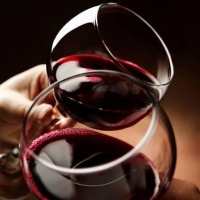
Evaluating the Wine by Sight
Examine the wine. The glass should be about one-third full and you should loosely follow the following steps to completely evaluate the wine visually.
Straight Angle View:
Look straight down into your glass, Next hold the glass to the light followed by give it a tilt, so the wine rolls toward edges of your glass. This will allow you to see the wine’s complete color range.
While looking down, you get a sense of the depth of color, which gives a clue to the density and saturation of the wine. You will also learn to identify certain varietal grapes by color and scent. A deeply-saturated, purple-black color might well be syrah or zinfandel, while a lighter, pale brick red shade would suggest pinot noir or sangiovese.
Side View:
Viewing the wine through the side of the glass allows the light to shows you how clear the wine is.
A murky wine might be a wine with chemical or fermentation problems. However, it might just be a wine that was unfiltered or has some sediment due to being agitated before the pour. A wine that looks clear and brilliant is always a good sign.
Tilted View:
Tilting the glass so the wine thins out toward the rim will provide clues to the wine’s age and weight. If the color looks quite pale and watery near its edge, it suggests a rather thin, possibly insipid wine. If the color looks tawny or brown (whites) or orange or rusty brick (reds) it is either an older wine or a wine that has been oxidized and may be past its prime. Don’t give up just yet.
Swirl the wine:
Finally, give the glass a good swirl. You can swirl it most easily by keeping it firmly on a flat surface, my favorite; open air “freestyle” swirling is not recommended for beginners. The point is you want some of the wine to cling to the side of your glass.
Notice if the wine forms “legs” or “tears” that run down the sides of the glass. Wines that have good legs are wines with more alcohol and glycerin content, which generally indicates that they are bigger, riper, more mouth-filling and dense than those without legs.
Now the Sniff:
Now that you’ve given the wine a good look, you’re ready to take a good sniff. Give the glass a swirl, but don’t bury your nose inside it. Instead, you want to hover over the top . Take a series of quick, short sniffs, then step away and let the information register with your brain.
There are many guides to help you train your nose to identify key wine fragrances, both good and bad. There are potentially thousands of aroma components in a glass of good wine, so forget about finding them all. Naming all the fruits, flowers, herbs and other scents you can trowel out of the glass can be a fun, but it’s not essential to enjoying and learning how to taste wine. Once you’ve taken a few quick, short sniffs of the wine, try to look for the following aromas, which will help you better understand the wine’s characteristics.
Sip:
Now time to taste your wine. For the first stage of tasting, take a small sip let it sit on your tongue. Roll it around in your mouth. Take a small breath of air and swirl the wine in your mouth. Do you taste what you smelled? How long does the flavor last? Was it full bodied or light? What is your initial impression that the wine makes on your palate? Do you notice the alcohol content, tannin levels or acidity? Does it taste differently after swirling it?
Now take a second sip. What is the wine’s actual taste on your palate? For red wines some examples of common tastes are– fruity, spicy, woody or smokiness. Flavors that may be found in white wine include fruity, floral, buttery, and earthy.
Savor:
Now to examine the finish of the wine. After you swallow, take your time and exhale gently through your nose and mouth.
Some questions to ask yourself about the wine’s finish (aftertaste).
- How long does the taste linger after swallowed?
- Do you want another sip?
- Was it too bitter?
- What foods do think this wine would go well with it?
- Would you buy this wine again?
Remember, as you begin tasting taking little notes. These notes are your personal perceptions of the wines your have tasted. There really are no right or wrong answers. Taking the time to consider what characteristics you like and dislike in wine will help to deepen your appreciation for wine and further the enjoyment of your wine tasting experience!
